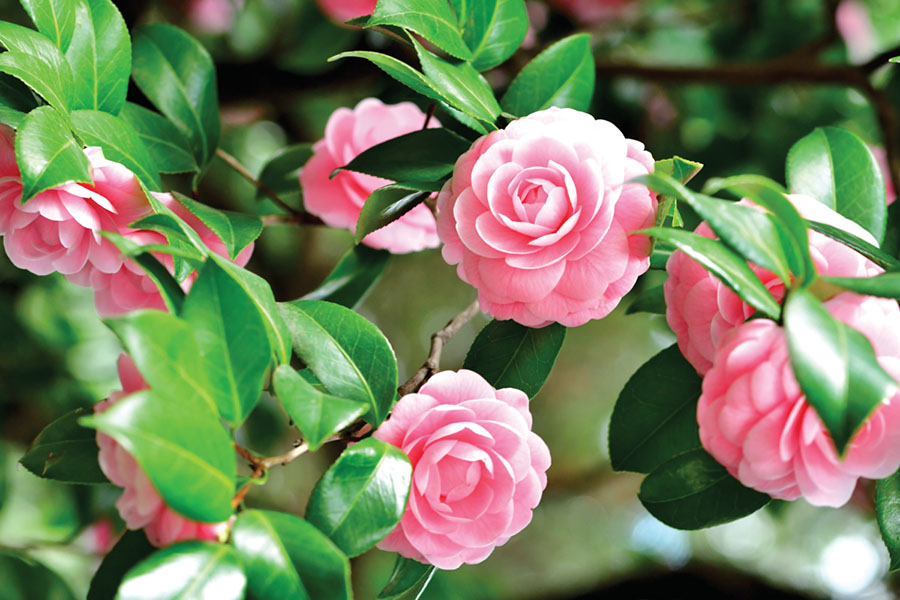
Bright blue skies, a crispness to the air and beautiful temperatures for enjoying the Florida weather – what could make this scene better? Beautiful flowers in your landscape like camellias and azaleas, of course. These early springlike bloomers have long been loved in traditional Florida landscapes, and they continue to be used as foundation plantings, screens, accent plants and hedges.
Come On, Camellias
Camellias are sometimes called the rose of winter because of their large, showy flowers. The bloom colors are variable, coming in white, red, pink, fuchsia and combinations of those. In addition, they have different flower types ranging from single petal, anemone and peony forms to double forms.
Depending on the variety, sasanqua camellias (Camellia sasanqua) will begin blooming in the late fall, and Camellia japonica blooms from fall to spring. Some of our true and tested favorite camellia varieties are Professor Sargent, Pink Perfection,
Debutante and Betty Sheffield. With so many varieties to choose from, it is worth a trip to a botanical garden, like Alfred B. Maclay Gardens State Park in Tallahassee, Bok Tower Gardens in Lake Wales or Leu Gardens in Orlando, to view their extensive collections and identify your favorites.
Camellias have a long lifespan, so plan on spending a little time thinking about where to plant them. Remember, you always want to put the right plant in the right place. Most camellias will perform best if you plant them in a sheltered location where they receive partial shade. However, some sasanqua camellia varieties will tolerate more sun if they receive adequate irrigation.
Camellias should be planted in well-drained, preferably acidic soil and be watered regularly for the first year until they’re established. After that, they can typically survive on rainfall alone, though they’ll perform better if irrigated during dry spells.
Any pruning should be done before late summer when the flower buds form, though sasanqua camellias generally require only occasional grooming thanks to their slow growth and natural form.
See more: 4 Benefits of Home Gardening
Awe-Inspiring Azaleas
Azaleas are a classic Southern plant, both for the structure they provide year-round and the magnificent floral displays they produce. Few other flowering shrubs put on such a spectacular show. Some azaleas produce so many flowers at once that you can hardly see the leaves! They start flowering in late winter and, depending on the variety, can bloom into March.
Most of the heavy blooming evergreen azaleas growing in Florida home landscapes are hybrids and came from Asia originally.
Florida native azaleas have smaller, delicate-looking flowers that are fragrant. Native azaleas are deciduous and usually bloom with no leaves on the stems. As the name suggests, flame azaleas bloom orange to yellow flowers, and pinxter azalea blossoms are pink. Both grow to about 10 feet tall and attract butterflies and hummingbirds. Native azaleas prefer well-drained acidic soil and filtered sunlight.
Evergreen azaleas hold their leaves year-round, so they make worthy backdrop plants for seasonal flower beds. In the spring, they put on their own show with flowers ranging from white to pink to red, depending on the cultivar.
One widely planted evergreen cultivar is George Lindley Taber, a variety that produces countless soft pink flowers each spring and grows to about 10 feet tall and 8 feet wide. George Taber is classified as a Southern Indica hybrid, a type favored by gardeners for its vigor and tolerance of colder temperatures, typically down to 20 degrees without experiencing severe damage.
Other popular Southern Indica hybrids include Brilliant (carmine red flowers), Formosa (brilliant rose-purple flowers) and Mrs. G.G. Gerbing (white flowers). Like the native azaleas, the Southern Indica hybrid thrives in well-drained acidic soil and is partial to filtered sunlight.
Prune azaleas after they have finished blooming. A good gardener’s rule of thumb for azalea pruning is that they should be pruned before the Fourth of July to ensure a good flower show for the following spring. Light fertilization and watering during dry periods will keep your azaleas blooming and healthy for many years.
For more information about camellias and azaleas, visit gardeningsolutions.ifas.ufl.edu or contact your local UF/IFAS County Extension Office.








